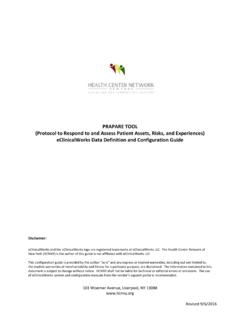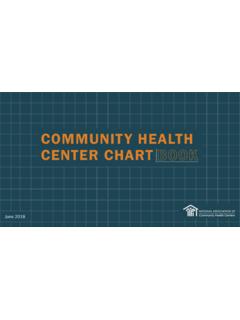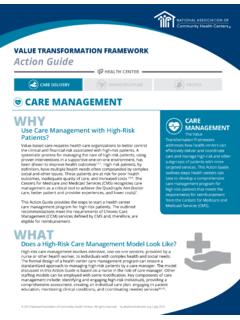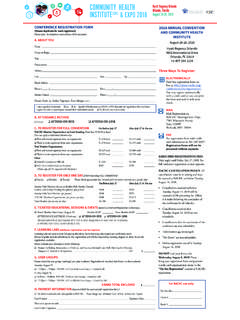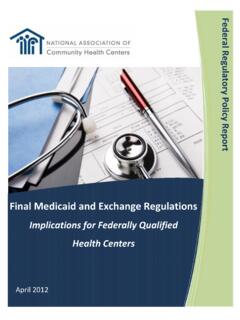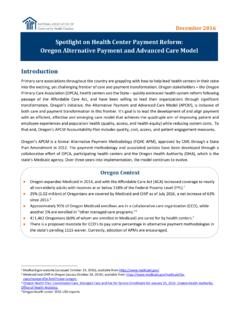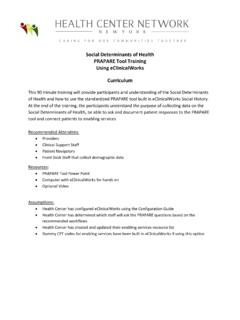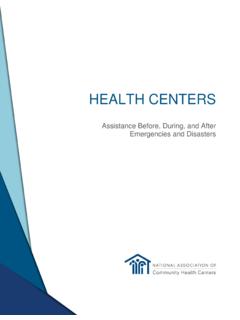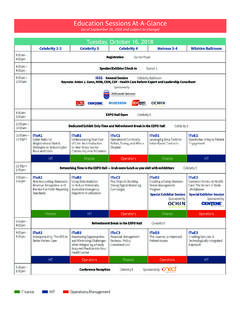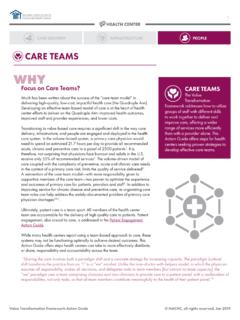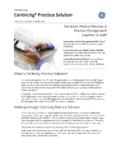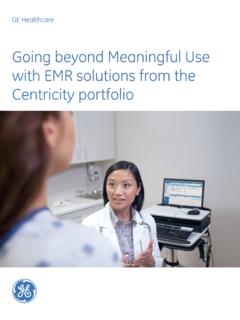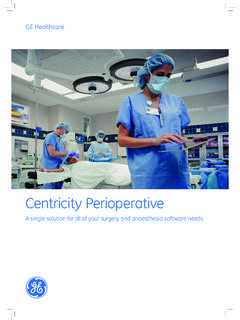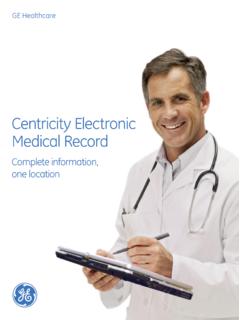Transcription of Patient Risk Assessment Tool: Training/User Manual for GE ...
1 2016 Patient Risk Assessment tool : Training/User Manual for GE Centricity Users NACHC/AAPCHO/OPCA/ALLIANCE OF CHICAGO MICHELLE JESTER 1 Table of Contents Overview of the PRAPARE Project 2 Standard Data Collection Workflow 5 PRAPARE tool Form Screenshot 7 PRAPARE Form FAQ 9 Change Management 14 Social Determinants of Health Sensitivity training 16 Best Practices & Lessons Learned 17 2 Overview of the PRAPARE Project: Implementing a National Standardized Patient Risk Assessment in Electronic Health Record Systems [Taken from NACHC s Implementing a National Standardized Patient Risk Assessment in Electronic Health Record Systems Project Charter Document] Health Centers and the Social Determinants of Health: Implementing a National Standardized Patient Risk Assessment Protocol in Electronic Health Record Systems (EHRs) Background.
2 In September 2013, the National Association of Community Health Centers (NACHC), the Association of Asian Pacific Community Health Organizations (AAPCHO), the Oregon Primary Care Association (OPCA), and the Institute for Alternative Futures (IAF) launched a project funded by the Kresge Foundation, Kaiser Community Benefit, and Blue Shield of California Foundation to create, implement, and promote a national standardized Patient risk Assessment protocol that goes beyond medical acuity to identify risk related to the social determinants of health (SDH).
3 The goal of this project is to develop and pilot a consensus-driven national standardized Patient risk Assessment protocol in partnership with health centers and their networks to 1) help health centers better understand and manage their Patient populations, 2) support development of payment methodologies that sustains SDH-related interventions. Millions of people in the live in circumstances or with a history that significantly their health. These include social, environmental, and economic factors that influence an individual s health.
4 SDH act as barriers to good health outcomes and increase health care costs through preventable health care utilization. The national network of Community, Migrant, Homeless, and Public Housing Health Centers endeavors to overcome the SDH challenges experienced by their 23 million patients in their clinical practice and community activities. Fully addressing SDH, however, requires capturing data to document and better understand the specific SDH-related risks of their patients . Standardized data on non-clinical Patient risk ( education, employment, homeless status) will help health centers fully assess Patient and community needs, identify high priorities, develop sustainable, coordinated, and culturally and linguistically appropriate interventions, and ultimately impact SDH risks , outcomes, costs, and Patient experiences.
5 It will also help inform new payment systems as current systems do not adequately incentivize the prevention or management of SDH nor do they cultivate community partnerships necessary for approaching health holistically. This tool was designed specifically to aid health centers in gathering data that informs and addresses individual Patient care and population health management, while capturing what makes health center populations unique. 3 PRAPARE will be used to meet these goals by: 1. Patient and Family: Empowering patients - Asking Patient -centered questions about risk and allowing patients to prioritize needs - Opening up the conversation between patients and their care team about non-clinical risks and unmet needs 2.
6 Care Team Members: Improving point of service care management - Giving the care team information on Patient risk/needs prior to the visit to inform counseling and referrals during visit - Giving the care team a more complete context of the Patient s medical conditions, risks , and utilization patterns 3. Health Center: Improving the health of the Patient population - Gathering data that can be aggregated to inform the allocation of resources and services and to identify disparities between Patient population segments 4.
7 Community Policies: Informing policies - Gathering data that can be aggregated to inform/promote legislation and policies ( , continued federal 330 funding, direct state grants, policies around specific social determinants, like housing) 5. Local Health System: Encouraging and strengthening partnerships across organizations - Encouraging local partnerships for bi-directional referral services - Creating an opportunity for meaningful data sharing (eg. ACO model of sharing utilization data, sharing aggregate data for comparison across healthcare organizations) 4 6.
8 State and National Policies: Gathering evidence for advocacy and payment reform - Gathering robust quality data to validate a risk adjustment algorithm for payment negotiation WHY Should Your Organization help Pilot PRAPARE? This tool was developed to help further the mission of your organization and we need your help ! It is based on research and stakeholder input, but needs to be tested by staff in the field to make it as strong as possible. This is your chance to test and provide feedback on a tool that will ultimately be nationally disseminated.
9 Piloting PRAPARE is an opportunity for innovation and problem solving in multiple areas of clinic work flow. Data collection process: Currently, most Patient data is gathered in the waiting room or during the exam. There are other interaction times which are an underutilized resource for Assessment administration. Prior to Patient arrival at clinic (reminder phone calls, online Patient portals) Prior to Patient exam (during measurement of vital signs, during wait in exam room) After the Patient leaves the exam room (in-house referrals for further Assessment , during check-out)
10 5 Standard Data Collection Workflow Depending on your health center s internal workflows and operations, the data collection workflow will be tailored towards your health center and what works best in your organization s operational workflow. Below is a standard data collection workflow where the PRAPARE questions are embedded within a normal office visit. The Alliance of Chicago is recommending that the data collection is done within two workflows: 1. Standard Office Visit 2.
